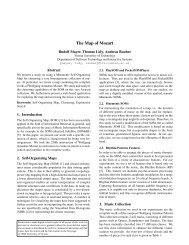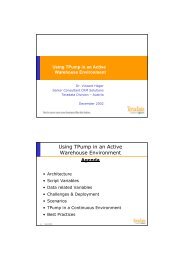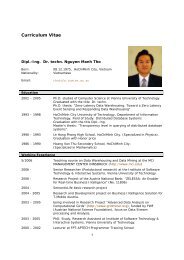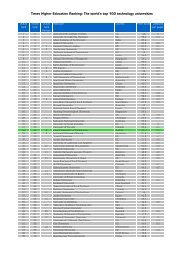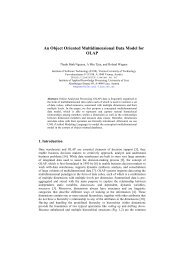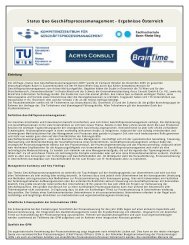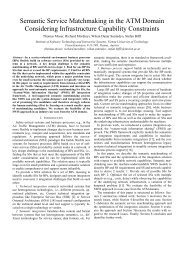Using Ontologies for Enterprise Architecture Model Alignment
Using Ontologies for Enterprise Architecture Model Alignment
Using Ontologies for Enterprise Architecture Model Alignment
Create successful ePaper yourself
Turn your PDF publications into a flip-book with our unique Google optimized e-Paper software.
<strong>Using</strong> <strong>Ontologies</strong> <strong>for</strong> <strong>Enterprise</strong> <strong>Architecture</strong><br />
<strong>Model</strong> <strong>Alignment</strong><br />
Gonçalo Antunes 1 , Artur Caetano 1,2 ,<br />
Marzieh Bakhshandeh 1 , Rudolf Mayer 3 , and José Borbinha 1,2<br />
1 Instituto Superior Técnico, University of Lisbon,<br />
Av. Rovisco Pais 1, 1049-001 Lisboa, Portugal,<br />
2 In<strong>for</strong>mation Systems Group, INESC-ID,<br />
Rua Alves Redol 9, 1000-029 Lisboa, Portugal,<br />
3 SBA Research, Favoritenstraße 16, 1040 Wien, Austria<br />
{goncalo.antunes,artur.caetano}@ist.utl.pt<br />
Abstract. One of the primary goals of enterprise architecture aligning<br />
the business with the underlying support systems. An architecture description<br />
encompasses an heterogeneous spectrum of domains, such as<br />
business processes, application components, metrics, people and technological<br />
infrastructure. Views express the domain elements and their<br />
relationships from the perspective of specific concerns relevant to the<br />
system stakeholders. Thus, each view needs to be expressed in the description<br />
language that best suits its concerns. However, enterprise architecture<br />
languages often specify meta-models that cross-cut distinct<br />
architectural domains. This hinders extensibility and adds complexity<br />
to the language. Ob the other hand, describing each domain through a<br />
specialized language and then integrating the multiple languages raises<br />
challenges at the level of traceability and consistency. This paper proposes<br />
using ontologies to integrate different enterprise architecture domains<br />
and to analyse the resulting models. This goal is realized through<br />
a core domain-independent language that is extended by several domainspecific<br />
languages, each focussing on a set of specific concerns. The approach<br />
contributes to the alignment of the different domains while ensuring<br />
traceability and model consistency. The proposal is demonstrated<br />
through an evaluation scenario that employs ArchiMate as the domainindependent<br />
language extended with a set of domain-specific languages.<br />
The demonstration shows that the different domains can be consistently<br />
aligned and analysed through the use of ontologies.<br />
Key words: enterprise architecture, alignment, separation of concerns,<br />
ArchiMate, ontology, OWL<br />
1 Introduction<br />
<strong>Enterprise</strong> architecture (EA) is defined by Lankhorst as “a coherent whole of<br />
principles, methods, and models that are used in the design and realization<br />
of an enterprise’s organizational structure, business processes, in<strong>for</strong>mation sys-
2 G. Antunes, A. Caetano et al.<br />
tems, and infrastructure” whose models “focus on alleviating the infamous business–in<strong>for</strong>mation<br />
technology alignment problem” [1]. <strong>Alignment</strong> results from applying<br />
models, methods, patterns and best practices to the specification and<br />
governance of the different domains of an organisation[2, 3, 4, 5]. Managing<br />
dependencies is fundamental <strong>for</strong> supporting the communication between the different<br />
stakeholders and to maintain the consistency at model and meta-model<br />
level [6, 7]. Moreover, EA governance requires the ability to analyse artefacts<br />
[1, 8] and it is also required to assist business analytics [9].<br />
Despite the ef<strong>for</strong>ts <strong>for</strong> developing comprehensive approaches to architecture,<br />
such as TOGAF [10], a “one model fits all” is unable to address the specific<br />
domains of an organization [11, 12]. Different organizations have specific needs<br />
and thus place particular demands on the EA models’ artefacts. As such, the<br />
development of an architecture description language entails ensuring the consistency<br />
and traceability between the language concepts [13, 1]. On the other hand,<br />
creating a consistent and comprehensive architecture description language that<br />
deals with specific domains is a challenge despite existing situational method<br />
approaches to enterprise architecture management [14].<br />
According to the ISO 42010 standard, the usage of multiple views is fundamental<br />
to describe a system’s architecture. A system has multiple stakeholders,<br />
each with specific interests on the system. An architecture description should<br />
aggregate multiple views, materialized in a set of models, that are <strong>for</strong>mulated according<br />
to viewpoints expressing the concerns of the stakeholders of the systemof-interest<br />
[15]. In this way, an architecture works as a communication agent<br />
between stakeholders, as each is presented with is own view over the system of<br />
interest. Creating viewpoints may actually require using different meta-models,<br />
tools, and validation mechanisms. This creates hurdles to consistency checking<br />
and traceability. The integration and extension of models and underlying metamodels<br />
is common[16, 17]. But such approaches bring challenges at the level<br />
of traceability and consistency because it is difficult to trace concepts between<br />
different domains, a problem that is aggravated as the models evolve [18]. Moreover,<br />
the integration of different meta-models poses challenges to its validation<br />
[19].<br />
This paper is concerned with the question of how to enhance enterprise architecture<br />
modelling with regards to consistency and traceability. In this context,<br />
consistency means the quality of the artefacts being logically related. The goal is<br />
to integrate multiple enterprise architecture description languages as a means to<br />
assist alignment. Specifically, we investigate whether ontology technologies can<br />
be used to specify, integrate and analyse multiple enterprise architecture models<br />
and the underlying meta-models.<br />
<strong>Ontologies</strong> describe a domain model by associating meaning to its terms and<br />
relations. A more <strong>for</strong>mal and widely used definition is that of Grüber who defines<br />
an ontology as a “<strong>for</strong>mal specification of a conceptualisation” [20]. The<br />
importance of this technology is evidenced by the growing use of ontologies in a<br />
variety of application areas [21, 22] and, especially, by their role on the Semantic<br />
Web initiative [23, 24]. Ontology technologies are also used in the field of enter-
<strong>Enterprise</strong> <strong>Architecture</strong> <strong>Model</strong> <strong>Alignment</strong> 3<br />
prise architecture to <strong>for</strong>malize organizational artefacts and to assist with model<br />
analysis [25, 26, 27, 28, 29, 30]. In fact, there is a wide body of knowledge that<br />
may improve the practice of EA, including ontology matching [31], and model<br />
extension and validation [32]. <strong>Ontologies</strong> facilitate the construction of complex<br />
models and can assist model analysis by depicting the consequences of a model.<br />
Formal ontology technologies also contribute to viewing and understanding the<br />
implicit consequences of explicit statements and can help ensuring that a model<br />
is consistent [33].<br />
This paper posits that modelling the different enterprise architecture domains<br />
with a set of integrated description languages contributes to their alignment because<br />
consistency and traceability become ascertained. The approach entails<br />
using ontologies to represent and integrate the multiple architecture description<br />
languages and to analyse the resulting models. We argue <strong>for</strong> the integration<br />
of <strong>for</strong>mal ontologies and associated technologies as mechanisms <strong>for</strong> developing<br />
consistent enterprise architecture models. The combination of <strong>for</strong>mally specified<br />
models with their analysis via automatic mechanisms contributes to aligning the<br />
heterogeneous domains of an EA. One example is the impact analysis of changes<br />
from the business on the IT infrastructure and vice-versa. The main contribution<br />
of this paper is thus proposing an architecture based on the use of ontologies with<br />
the purpose of enhancing the extensibility with domain-specific aspects while en<strong>for</strong>cing<br />
consistency. We demonstrate the applicability of the proposal through<br />
the application of <strong>for</strong>mal ontologies to model a set of different EA domains and<br />
through the consistent integration of these domains. In particular, we develop<br />
an ontology to specify the ArchiMate 2.0 meta-model and then create traceable<br />
maps to it from a set of domain-specific languages. We also describe an example<br />
that maps the sensor technology domain to ArchiMate in the context of a<br />
real-world scenario. This demonstration shows that the application of ontologies<br />
to enterprise architecture modelling effectively assists consistently aligning and<br />
analysing different domains.<br />
The rest of this paper is organized as follows: section 2 describes a ontologybased<br />
proposal to integrate and analyse enterprise architecture models; section<br />
3.1 describes the realization of the proposal; section 3 evaluates the solution<br />
using a scenario; finally, section 4 concludes the paper.<br />
2 <strong>Using</strong> <strong>Ontologies</strong> to Integrate <strong>Enterprise</strong> <strong>Architecture</strong><br />
Meta-<strong>Model</strong>s<br />
This paper proposes an ontology-based framework to <strong>for</strong>malize and integrate different<br />
domains of an enterprise architecture. The design of this artefact adheres<br />
to the following architectural principles:<br />
– Concern orientation. The architecture represents the concepts that address<br />
an explicit set of concerns as a meta-model. The meta-model will not support<br />
any concepts that are not derived from the stakeholders’ concerns.
4 G. Antunes, A. Caetano et al.<br />
– Viewpoint-orientation. The architecture supports defining views over subsets<br />
of its concepts. This facilitates communication because viewpoints act as<br />
a separation of concerns mechanism. Viewpoints facilitate addressing multiple<br />
concerns and can improve decision-making by isolating certain aspects of the<br />
architecture according to the needs of stakeholders.<br />
– Expressiveness. The architecture represents a set of unambiguous domain<br />
concepts. This entails defining the minimum set of consistent types and relationships<br />
to describe the domain.<br />
– Extensibility. The architecture supports the integration of multiple domainspecific<br />
and domain-independent meta-models while minimizing coupling.<br />
– Modularity. The architecture observes high-cohesion and low-coupling. Observing<br />
these qualities contributes to the expressiveness and extensibility of<br />
the architecture with the goal of minimizing the impact of adding new domainspecific<br />
concepts.<br />
The framework uses a core meta-model to <strong>for</strong>malize the concepts that are<br />
domain-independent This meta-model is <strong>for</strong>malized as an upper-level ontology<br />
and is designated domain-independent ontology (DIO). The design goal of the<br />
DIO is to identify a minimum set of concepts pertaining to the central modelling<br />
domain (in this case, enterprise architecture). The concepts of the DIO<br />
are extended by defining a variable number of domain-specific meta-models,<br />
depending on the particular system concern. Each domain-specific meta-model<br />
is <strong>for</strong>malized as a domain-specific ontology (DSO). Thus, a DSO represents a<br />
domain-specific language that addresses a particular set of concerns, and should<br />
also have the minimum set of concepts required <strong>for</strong> describing a determined domain.<br />
There<strong>for</strong>e, separation of concerns, low-coupling and high-cohesion are the<br />
primary qualities that affect the DIO and DSO design.<br />
Ontology integration is required to link concepts from the DIO to the DSO.<br />
Integration combines different ontologies while ensuring consistency and maximum<br />
coverage of the domain being addressed. The simplest case is that of<br />
integrating the DSO concepts with the core concepts represented in the DIO.<br />
Cross-DSO integration occurs whenever more expressiveness power to specific<br />
domains. The ontology integration makes use of model trans<strong>for</strong>mation, which<br />
involves defining a mapping strategy from a source model to a target model<br />
[34, 35]. Figure 1 depicts the types of trans<strong>for</strong>mation maps between the DIO<br />
and the DSOs. A map attempts to relate the concepts from a source to a destination<br />
ontology so that there is a one-to-one correspondence between each<br />
pair of concepts. Three types of mapping deficiencies may occur [36]. A source<br />
concept may map to more than one destination concept resulting in overload,<br />
a source concept may not be mappable to any destination resulting in deficit,<br />
or several source concepts may map to the same destination concept leading to<br />
redundancy.<br />
The models that result from instantiating the integrated DIO and DSO can<br />
be analysed and properties and relations can be inferred through reasoners. Four<br />
types of reasoning are possible with this architecture:DIO reasoning when inference<br />
is limited to the DIO concepts, DSO reasoning, when inference is limited
<strong>Enterprise</strong> <strong>Architecture</strong> <strong>Model</strong> <strong>Alignment</strong> 5<br />
DIO<br />
DIO-DSO1<br />
Trans<strong>for</strong>mation Map<br />
DIO-DSO2<br />
Trans<strong>for</strong>mation Map<br />
DSO-1<br />
DSO-2<br />
DSO3-DSO2<br />
Trans<strong>for</strong>mation Map<br />
DSO-3<br />
Fig. 1: Mappings between domain-independent and domain-specific ontologies<br />
to the concepts of a single DSO, Cross-DSO reasoning, when inference use concepts<br />
from different mapped DSOs, and DIO-DSO reasoning, when inference<br />
uses concepts from the DIO and one or more DSOs.<br />
3 Application to <strong>Enterprise</strong> <strong>Architecture</strong><br />
This section describes the specification of a DIO, a DSO and an application of<br />
the integrated meta-models. The evaluation scenario concerns a civil engineering<br />
safety authority that needs to monitor large structures such as hydroelectric<br />
power dams, reservoirs and bridges. Each structure has different sensors that<br />
measure physical phenomena and produce data that is analysed to assess the<br />
structure throughout its life cycle. The business process that deals with the<br />
assessment of a structure includes activities that deal with the data acquisition<br />
and data analysis. An instance of this process may be active <strong>for</strong> decades, from<br />
the early construction phases until disposition. Part of this process is supported<br />
by an in<strong>for</strong>mation system that provides the following functions:<br />
– Instrumentation: manages sensor installation, configuration and deployment.<br />
– Trans<strong>for</strong>mation: manages the algorithms that trans<strong>for</strong>m sensor raw data into<br />
in<strong>for</strong>mation.<br />
– Observation: manages geodetic data, visual inspections data, and the data<br />
acquired from monitoring systems.<br />
– Analysis: manages data analysis, visualization and reporting.<br />
– Synchronization: synchronizes data between multiple locations and systems.<br />
The organization is required to acquire and preserve the monitoring data during<br />
the entire structure’s life cycle. There<strong>for</strong>e, capturing in<strong>for</strong>mation about the<br />
acquisition processes and supporting technological infrastructure is fundamental<br />
to attest the provenance and authenticity of the monitoring data. Moreover,<br />
historic data can be used to analyse and predict the behaviour of the structure.<br />
In this setting, enterprise architecture plays a valuable role to assist with the<br />
specification, evolution and the alignment of these processes with the supporting<br />
technology.<br />
This scenario was modelled with the ArchiMate 2.0 language. Although<br />
ArchiMate is able to specify the different domains of this scenario, at a highlevel<br />
of abstraction, it has not the expressiveness required to model the domainspecific<br />
concerns pertaining to sensors and acquisition. The first step was to
6 G. Antunes, A. Caetano et al.<br />
create an ArchiMate model of the scenario (the models were produced with the<br />
Archi tool 1 ). Figure 2 depicts an overview of the acquisition process and the<br />
services supporting it. Figure 3 depicts an overview of the application components<br />
and underlying technological infrastructure. The ArchiMate model was<br />
then exported from the Archi tool and automatically converted to OWL using<br />
a specialized tool.<br />
Fig. 2: Business processes and application infrastructure<br />
Fig. 3: Technological infrastructure<br />
3.1 The ArchiMate Domain-Independent Ontology<br />
ArchiMate describes the domain-independent aspects of the architecture, focussing<br />
on the core concepts pertaining to enterprise architecture. The DIO is<br />
1 http://archi.cetis.ac.uk/
<strong>Enterprise</strong> <strong>Architecture</strong> <strong>Model</strong> <strong>Alignment</strong> 7<br />
there<strong>for</strong>e a specification of the ArchiMate meta-model using OWL-DL. OWL-<br />
DL enables taking advantage of existing inference and querying mechanisms to<br />
analyse the models and assessing their consistency. The ArchiMate ontology was<br />
mainly developed according to the ontology engineering methodology defined by<br />
Horridge [37]. The steps include:<br />
1. Identification of the concepts and concept hierarchy.<br />
2. Identification of the disjoint concepts.<br />
3. <strong>Model</strong>ling composition.<br />
4. Addition of all the relationships between concepts.<br />
5. Identification of definitions.<br />
6. Addition of annotations.<br />
7. Refinement of the ontology through various iterations of the above steps.<br />
The resulting ontology maps the ArchiMate concepts to OWL Classes and<br />
relations to OWL ObjectProperties. Restrictions were added to the properties,<br />
such as InverseObjectProperties and SuperObjectProperties, so that derived relationships<br />
can be correctly inferred. Figure 4 depicts a partial specification of<br />
ArchiMate’s business function as displayed in Protégé 4.3.<br />
Fig. 4: Partial OWL-DL specification of an ArchiMate Business Function<br />
3.2 The Domain-Specific Ontology<br />
The organizational stakeholders required modelling and analysing specific in<strong>for</strong>mation<br />
about sensors. However, the ArchiMate language lacks the expressiveness<br />
to capture the specifics of this domain. Sensors measure values that can be processed<br />
and used in structural analysis. There are sensors <strong>for</strong> making different<br />
measurements, which have specific trans<strong>for</strong>mation algorithms and calibration
8 G. Antunes, A. Caetano et al.<br />
Fig. 5: Core structure of the sensor DSO<br />
values. Some sensors are geo-referenced and some capture data according to dynamic<br />
acquisition rates. As such, the particularities of this domain imply defining<br />
a DSO. The organization considered different sensor modelling languages, such<br />
as SensorML 2 and TransducerML 3 , but decided that their expressiveness was<br />
insufficient to address specific concerns. As such, we developed a DSO based on<br />
SensorML that addresses the concerns of this organization using the ontology<br />
engineering methodology described earlier. The core concepts of the sensor DSO<br />
are depicted in figure 5. The trans<strong>for</strong>mation map from the sensor DSO to the<br />
ArchiMate DIO contains the relations described on Table 1.<br />
Table 1: Mappings between the Sensor DSO and the ArchiMate DIO<br />
Sensor DSO<br />
Sensor<br />
GeoLocation<br />
StructuralLocation<br />
Algorithm<br />
Value<br />
AcquisitionRatePerYear<br />
ArchiMate DIO<br />
Node<br />
Location<br />
Location<br />
ApplicationComponent<br />
Data Object<br />
Data Object<br />
3.3 <strong>Model</strong> Analysis<br />
One of the stakeholder concerns relates to the technological infrastructure elements<br />
that support the acquisition process. This concern can be addressed<br />
2 http://www.ogcnetwork.net/SensorML<br />
3 http://www.ogcnetwork.net/infomodels/tml
<strong>Enterprise</strong> <strong>Architecture</strong> <strong>Model</strong> <strong>Alignment</strong> 9<br />
through DIO reasoning, i.e. via the ArchiMate meta-model. Figure 6 depicts the<br />
question <strong>for</strong>malized as a OWL-DL query along with the ObjectProperty chains<br />
that identify the 19 instances that support the acquisition process. An example<br />
of intra-DSO reasoning is depicted on figure 7 that depicts the sensors that are<br />
able to make temporal readings. Finally, figure 8 shows the result of DIO-DSO<br />
reasoning where the integrated models are queried about which ArchiMate ApplicationComponents<br />
rely on the reading of the sensors of type Drain. In the<br />
latter case, the reasoner uses the mappings between the Sensor DSO and the<br />
ArchiMate DIO to infer the reasoning chains and thus to answer the query.<br />
Fig. 6: Intra-DIO query results<br />
Fig. 7: Intra-DSO query results<br />
Fig. 8: Cross DIO-DSO query results
10 G. Antunes, A. Caetano et al.<br />
4 Conclusions<br />
This paper proposes using ontologies to integrate different enterprise architecture<br />
domains and to analyse the resulting models. This goal is realized through<br />
the specification of a core domain-independent ontology that is extended by a set<br />
of domain-specific ontologies, each focussing on specific concerns. The approach<br />
contributes to the alignment of the different domains while ensuring traceability,<br />
consistency and extensibility. As observed from the case study, <strong>for</strong>mal ontologies<br />
can enhance the quality of meta-modelling due to their automated analysis<br />
capability that can be used to assess meta-model consistency as well as to assess<br />
model con<strong>for</strong>mance. Moreover, ontologies positively contribute to enterprise<br />
architecture alignment because multiple meta-models can be integrated and represented<br />
in such a way that its in<strong>for</strong>mation can be traced and analysed and the<br />
reasoning consequences be exposed. The proposal was evaluated using ArchiMate<br />
as the DIO. To do that, we converted the ArchiMate meta-model to OWL-DL. A<br />
scenario was modelled using the ArchiMate DIO and its domain-specific aspects<br />
were modelled using a set of DSOs. In particular, this paper partially described<br />
one of the DSOs, the Sensor DSO, and exemplified different types of analysis<br />
that can be accomplished using this approach. This demonstration shows that<br />
the application of ontologies to enterprise architecture modelling effectively assists<br />
consistently aligning and analysis different domains.<br />
Our current work focuses on extending the analysis capabilities to support the<br />
validation of models and the assessment of models and meta-models. We are also<br />
working on a set of automated and semi-automated extractor and process mining<br />
tools to instantiate the domain-specific and domain-independent ontologies with<br />
operational data to test the con<strong>for</strong>mance of the “should-be” models towards the<br />
actual “as-is” models.<br />
Acknowledgements<br />
This project is partially supported by the European Commission under the<br />
7th Framework Programme (FP7/2007-2013) under grant agreement 269940,<br />
TIMBUS project (http://timbusproject.net) and by COMET K1, FFG,<br />
Austrian Research Promotion Agency. Gonçalo Antunes is partially supported<br />
by FCT, Fundação para a Ciência e a Tecnologia, through project PEst-<br />
OE/EEI/LA0021/2011 and grant SFRH/BD/69121/2010.<br />
References<br />
1. Lankhorst, M.: <strong>Enterprise</strong> <strong>Architecture</strong> at Work: <strong>Model</strong>ing, Communication, and<br />
Analysis. 3 edn. Springer (2013)<br />
2. Pereira, C.M., Sousa, P.M.A.: <strong>Enterprise</strong> architecture: business and it alignment.<br />
In Haddad, H., Liebrock, L.M., Omicini, A., Wainwright, R.L., eds.: SAC, ACM<br />
(2005) 1344–1345
<strong>Enterprise</strong> <strong>Architecture</strong> <strong>Model</strong> <strong>Alignment</strong> 11<br />
3. Winter, R., Fischer, R.: Essential layers, artifacts, and dependencies of enterprise<br />
architecture. In: <strong>Enterprise</strong> Distributed Object Computing Conference Workshops,<br />
2006. EDOCW’06. 10th IEEE International, IEEE (2006) 30–30<br />
4. Wegmann, A., Balabko, P., Lê, L.S., Regev, G., Rychkova, I.: A method and tool<br />
<strong>for</strong> business-it alignment in enterprise architecture. In: Proceedings of the CAiSE.<br />
Volume 5., Citeseer (2005) 113–118<br />
5. Caetano, A., Silva, A.R., Tribolet, J.M.: Business process decomposition - an<br />
approach based on the principle of separation of concerns. <strong>Enterprise</strong> <strong>Model</strong>ling<br />
and In<strong>for</strong>mation Systems <strong>Architecture</strong>s 5(1) (2010) 44–57<br />
6. Galster, M.: Dependencies, traceability and consistency in software architecture:<br />
towards a view-based perspective. In: ECSA ’11 Proceedings of the 5th European<br />
Conference on Software <strong>Architecture</strong>: Companion Volume. (2011)<br />
7. Romero, J., Jaen, J.I., Vallencillo, A.: Realizing correspondences in multi-viewpoint<br />
specifications. In: Proceedings of the 2009 IEEE International <strong>Enterprise</strong> Distributed<br />
Object Computing Conference. (2009)<br />
8. Buschle, M., Ullberg, J., Franke, U., Lagerstrom, R., Sommestad, T.: A tool <strong>for</strong><br />
enterprise architecture analysis using the prm <strong>for</strong>malism. In: CAiSE Forum 2010,<br />
Hammamet, Tunisia, June 7-9, 2010, Selected Extended Papers. (2010)<br />
9. Binz, T., Leymann, F., Nowak, A., Schumm, D.: Improving the manageability<br />
of enterprise topologies through segmentation, graph trans<strong>for</strong>mation, and analysis<br />
strategies. In: 2012 16th IEEE International <strong>Enterprise</strong> Distributed Object<br />
Computing Conference (EDOC). (2012)<br />
10. The Open Group: TOGAF 9 - the open group architecture framework version 9<br />
(2009)<br />
11. Saat, J., Franke, U., Lagerstrom, R., Ekstedt, M.: <strong>Enterprise</strong> architecture meta<br />
models <strong>for</strong> it/business alignment situations. In: 2010 14th IEEE International<br />
<strong>Enterprise</strong> Distributed Object Computing Conference. (2010)<br />
12. Buckl, S., Matthes, F., Schweda, C.M.: Conceptual models <strong>for</strong> cross-cutting aspects<br />
in enterprise architecture modeling. In: 2010 14th IEEE International <strong>Enterprise</strong><br />
Distributed Object Computing Conference Workshops. (2010)<br />
13. Braun, C., Winter, R.: A comprehensive enterprise architecture metamodel and<br />
its implementation using a metamodeling plat<strong>for</strong>m. <strong>Enterprise</strong> <strong>Model</strong>ling and In<strong>for</strong>mation<br />
Systems <strong>Architecture</strong>s (2005) 64–79<br />
14. Buckl, S., Schweda, C.M., Matthes, F.: A design theory nexus <strong>for</strong> situational<br />
enterprise architecture management. In: 2010 14th IEEE International <strong>Enterprise</strong><br />
Distributed Object Computing Conference Workshops. (2010)<br />
15. ISO: ISO/IEC/IEEE 42010:2011 - systems and software engineering - architecture<br />
description (2011)<br />
16. Burmester, S., Giese, H., Niere, J., Tichy, M., Wadsack, J.P., Wagner, R., Wendehals,<br />
L., Zundorf, A.: Tool integration at the meta-model level: the fujaba approach.<br />
Int J Softw Tools Technol Transfer 6 (2004) 203–218<br />
17. Kapsammer, E., Reiter, T., Schwinger, W.: <strong>Model</strong>-based tool integration - state of<br />
the art and future perspectives. In: Proceedings of the 3rd International Conference<br />
on Cybernetics and In<strong>for</strong>mation Technologies, Systems and Applications (CITSA<br />
2006). (2006)<br />
18. France, R., Rumpe, B.: <strong>Model</strong>-driven development of complex software: A research<br />
roadmap. In: Future of Software Engineering, 2007. FOSE ’07. (2007)<br />
19. Almeida, J.P.A., Iacob, M.E., van Eck, P.: Requirements traceability in modeldriven<br />
development: Applying model and trans<strong>for</strong>mation con<strong>for</strong>mance. Inf Syst<br />
Front 9 (2007) 327–342
12 G. Antunes, A. Caetano et al.<br />
20. Grüber, T.: A translation approach to portable ontology specifications. Knowledge<br />
Acquisition 5(2) (1993) 199–220<br />
21. Happel, H.J., Seedorf, S.: Applications of ontologies in software engineering. In:<br />
In 2nd International Workshop on Semantic Web Enabled Software Engineering<br />
(SWESE 2006), held at the 5th International Semantic Web Conference (ISWC<br />
2006). (2006)<br />
22. Burger, T., Simperl, E.: Measuring the benefits of ontologies. In: On the Move to<br />
Meaningful Internet Systems: OTM 2008 Workshops. (2008)<br />
23. Shadbolt, N., Hall, W., Berners-Lee, T.: The semantic web revisited. IEEE Intelligent<br />
Systems Journal 4 (2006) 96–101<br />
24. Berners-Lee, T., Hendler, J., Lassila, O.: The semantic web. Scientific American<br />
(May 2001) 29–37<br />
25. Uschold, M., Uschold, M., King, M., King, M., House, S.B.R., Moralee, S., Moralee,<br />
S., Zorgios, Y., Zorgios, Y.: The enterprise ontology. The Knowledge Engineering<br />
Review 13 (1995) 31–89<br />
26. Geerts, G.L., McCarthy, W.E.: An ontological analysis of the economic primitives<br />
of the extended-rea enterprise in<strong>for</strong>mation architecture. International Journal of<br />
Accounting In<strong>for</strong>mation Systems 3(1) (2002) 1 – 16<br />
27. Kang, D. ande Lee, J., Choi, S., Kwangsoo, K.: An ontology-based enterprise<br />
architecture. Expert Systems with Applications 37 (2010) 1456–1464<br />
28. Wagner, G.: <strong>Ontologies</strong> and rules <strong>for</strong> enterprise modeling and simulation. In:<br />
2011 15th IEEE International <strong>Enterprise</strong> Distributed Object Computing Conference<br />
Workshops. (2011)<br />
29. Azevedo, C.L.B., Almeida, J.P.A., van Sinderen, M., Quartel, D., Guizzardi, G.:<br />
An ontology-based semantics <strong>for</strong> the motivation extension to archimate. In: 2011<br />
15th IEEE International <strong>Enterprise</strong> Distributed Object Computing Conference.<br />
(2011)<br />
30. Almeida, J.P.A., Guizzardi, G.: An ontological analysis of the notion of community<br />
in the rm-odp enterprise language. Computer Standards & Interfaces 35(3) (2013)<br />
257 – 268<br />
31. Schvaiko, P., Euzenat, J.: A survey of schema-based matching approaches. Journal<br />
on Data Semantics IV, Lecture Notes in Computer Science 3730 (2005) 146–171<br />
32. Santos Jr., P.S., Almeida, J.P.A., Guizzardi, G.: An ontology-based semantic foundation<br />
<strong>for</strong> organizational structure modeling in the aris method. In: 2010 14th<br />
IEEE International <strong>Enterprise</strong> Distributed Object Computing Conference Workshops.<br />
(2010)<br />
33. Pidcock, W.: What are the differences between a vocabulary, a taxonomy, a thesaurus,<br />
an ontology, and a meta-model? available online http://infogrid.org/<br />
wiki/Reference/PidcockArticle(accessedApril2013) (2002)<br />
34. Guizzardi, G.: Ontological foundations <strong>for</strong> structural conceptual models. PhD<br />
thesis, University of Twente, Enschede, The Netherlands (2005)<br />
35. Rosemann, M., Green, P., Indulska, M.: A reference methodology <strong>for</strong> conducting<br />
ontological analyses. In: Proceedings of the 23rd International Conference on<br />
Conceptual <strong>Model</strong>ling (ER 2004). (2004)<br />
36. Bunge, M.A.: Treatise on Basic Philosophy Volume 3: Ontology I - The Furniture<br />
of the World. Kluwer Academic Publishers (1977)<br />
37. Horridge, M., Knublauch, H., Rector, A., Stevens, R., Wroe, C.: A practical guide<br />
to building owl ontologies using the protégé-owl plugin and co-ode tools edition<br />
1.2. The University Of Manchester (2009)


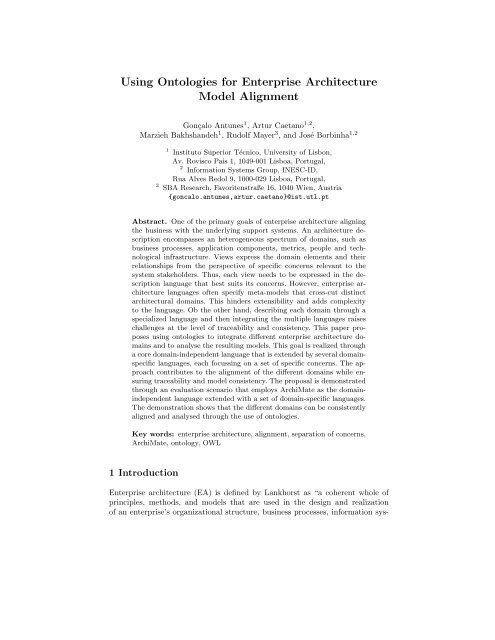
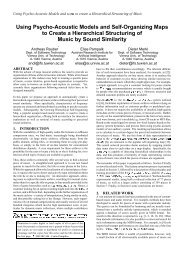


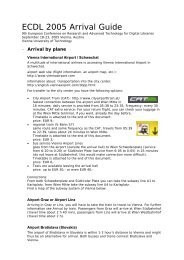
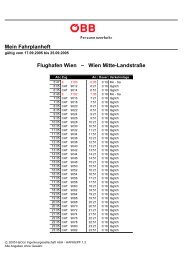
![Informationsvisualisierung [WS0708 | 01 ]](https://img.yumpu.com/22537403/1/190x143/informationsvisualisierung-ws0708-01-.jpg?quality=85)
